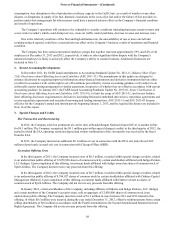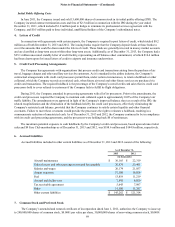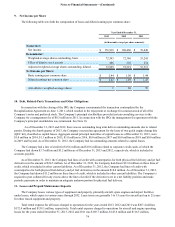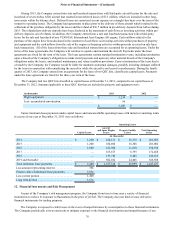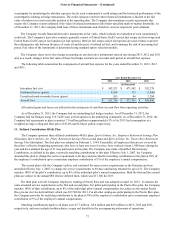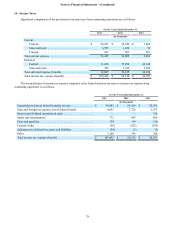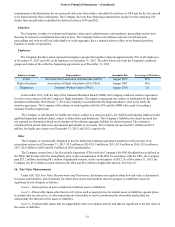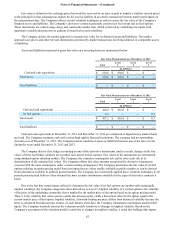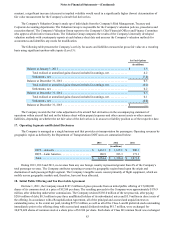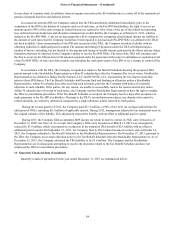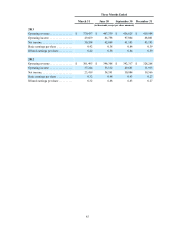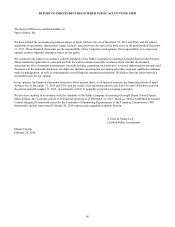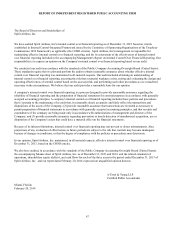Spirit Airlines 2013 Annual Report Download - page 77
Download and view the complete annual report
Please find page 77 of the 2013 Spirit Airlines annual report below. You can navigate through the pages in the report by either clicking on the pages listed below, or by using the keyword search tool below to find specific information within the annual report.
Notes to Financial Statements—(Continued)
77
counterparty by monitoring the absolute exposure levels, each counterparty's credit ratings and the historical performance of the
counterparties relating to hedge transactions. The credit exposure related to these financial instruments is limited to the fair
value of contracts in a net receivable position at the reporting date. The Company also maintains security agreements that
require the Company to post collateral if the value of selected instruments falls below specified mark-to-market thresholds. As
of December 31, 2013, the Company held none of these instruments and, therefore, was not required to post collateral.
The Company records financial derivative instruments at fair value, which includes an evaluation of each counterparty's
credit risk. The Company's derivative contracts generally consist of United States Gulf Coast jet fuel swaps (jet fuel swaps) and
United States Gulf Coast jet fuel options (jet fuel options). Both jet fuel swaps and jet fuel options are used at times to protect
the refining price risk between the price of crude oil and the price of refined jet fuel, and to manage the risk of increasing fuel
prices. Fair value of the instruments is determined using standard option valuation models.
The Company chose not to elect hedge accounting on any derivative instruments entered into during 2013, 2012 and 2011
and, as a result, changes in the fair value of these fuel hedge contracts are recorded each period in aircraft fuel expense.
The following table summarizes the components of aircraft fuel expense for the years ended December 31, 2013, 2012
and 2011:
Year Ended December 31,
2013 2012 2011
(in thousands)
Into-plane fuel cost . . . . . . . . . . . . . . . . . . . . . . . . . . . . . . . . . . . . . . . . $ 542,523 $ 471,542 $ 392,278
Settlement losses (gains) . . . . . . . . . . . . . . . . . . . . . . . . . . . . . . . . . . . . 8,958 175 (7,436)
Unrealized mark-to-market losses (gains) . . . . . . . . . . . . . . . . . . . . . . . 265 46 3,204
Aircraft fuel . . . . . . . . . . . . . . . . . . . . . . . . . . . . . . . . . . . . . . . . . . . . . . $ 551,746 $ 471,763 $ 388,046
All realized gains and losses are reflected in the statements of cash flows in cash flow from operating activities.
As of December 31, 2013, the Company had no outstanding fuel hedges in place. As of December 31, 2012, the
Company had fuel hedges using U.S. Gulf Coast jet fuel options as the underlying commodity. As of December 31, 2012, the
Company had agreements in place to protect 7.8 million gallons or approximately 5% of its 2013 fuel consumption at a
weighted-average ceiling and floor price of $3.09 and $2.84 per gallon, respectively.
13. Defined Contribution 401(k) Plan
The Company sponsors three defined contribution 401(k) plans, Spirit Airlines, Inc. Employee Retirement Savings Plan
(first plan), Spirit Airlines, Inc. Pilots’ Retirement Savings Plan (second plan) and Spirit Airlines, Inc. Puerto Rico Retirement
Savings Plan (third plan). The first plan was adopted on February 1, 1994. Essentially, all employees that are not covered by
the pilots’ collective bargaining agreement, who have at least one year of service, have worked at least 1,000 hours during the
year and have attained the age of 21 may participate in this plan. The Company may make a Qualified Discretionary
Contribution, as defined in the plan, or provide matching contributions to this plan. Effective July 1, 2007, the Company
amended this plan to change the service requirement to 60 days and provided for matching contribution to the plan at 50% of
the employee’s contribution up to a maximum employer contribution of 3% of the employee’s annual compensation.
The second plan is for the Company’s pilots, and contained the same service requirements as the first plan and was
amended effective July 1, 2007, to change the service requirements to 60 days and having attained the age of 21. The Company
matches 100% of the pilot’s contribution, up to 8% of the individual pilot’s annual compensation. Both the first and the second
plans are subject to the annual IRS elective deferral limit, which was $17,500 for 2013.
The third plan is for all Company employees residing in Puerto Rico and was adopted on April 16, 2012. It contains the
same amended service requirements as the first and second plans. For pilots participating in the Puerto Rico plan, the Company
matches 100% of their contribution, up to 8% of the individual pilot's annual compensation, but subject to the annual Puerto
Rico pre-tax elective deferral limit, which was $17,500 for 2013. For all other employees participating in the Puerto Rico plan,
the Company provides for matching contribution to the plan at 50% of the employee's contribution up to a maximum employer
contribution of 3% of the employee's annual compensation.
Matching contributions made to all plans were $7.7 million , $6.6 million and $4.9 million in 2013, 2012 and 2011,
respectively, and were included within salaries, wages and benefits in the accompanying statements of operations.



